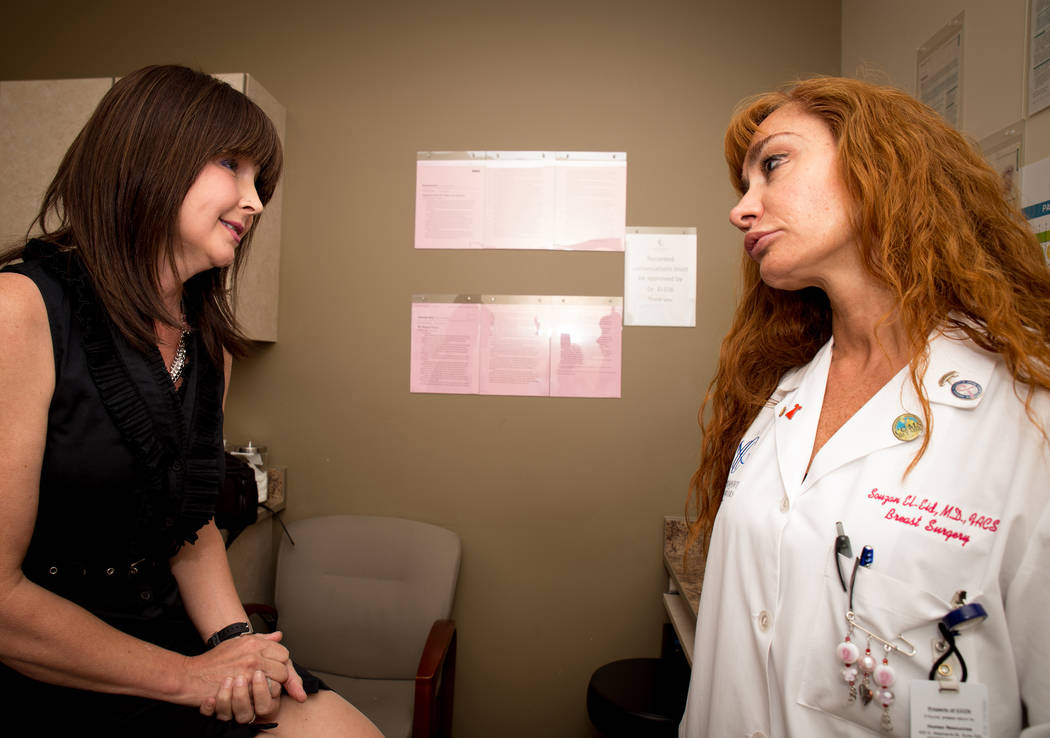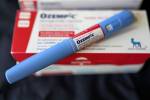Nipple-sparing mastectomy an option for some women
Mary Bennett was not your typical breast cancer patient.
A biology professor at the College of Southern Nevada’s Charleston campus, she teaches human anatomy and physiology and said she likely has “a little bit better … understanding of cancer than a lot of people do.”
Although that didn’t make receiving a HER2 positive breast cancer diagnosis in January any less troubling, Bennett said it did help that she is familiar with the various types of cancer surgeries and treatment options that are available.
After neoadjuvant therapy this spring, which included six rounds of chemotherapy that quickly shrunk her tumor and a swollen lymph node, her thoughts turned to surgery and breast reconstruction.
She had initially planned to have a breast-conserving lumpectomy followed by radiation therapy — that is, until she met with a plastic surgeon who advised that she was a good candidate for a nipple-sparing mastectomy.
Unlike a conventional mastectomy, during which the entire breast is removed, only glandular tissue is removed from underneath the breast skin, nipple and areola with a nipple-sparing mastectomy. This creates a sort of skin envelope into which an implant or tissue harvested from elsewhere in the body can be inserted as part of breast reconstruction.
The result typically is a more natural looking, aesthetically pleasing breast.
Surprisingly, Bennett, 54, said she previously had been unfamiliar with nipple-sparing mastectomies. She consulted with her breast surgeon, Dr. Souzan El-Eid of Comprehensive Cancer Centers of Nevada, and decided it was her best option.
“I thought about it for a night and was like, ‘This is going to give me a much more pleasing appearance afterward,’” she said. “You’ve seen pictures in the past where the women are just kind of butchered” by conventional mastectomies. “It’s not that I felt like if (the breast) was gone, I wouldn’t feel like a woman. I just wouldn’t feel like me.”
Bennett underwent surgery in late August, and her cancer is currently in remission.
“So far, for me, it’s been a fantastic experience,” she said, adding that she plans to have a nipple-sparing mastectomy performed on her other breast later this year in hopes of dodging another cancer diagnosis in the future.
Nipple-sparing mastectomies are not new, but they are gaining favor among doctors and patients for their ability to provide a better cosmetic outcome than conventional mastectomies and lumpectomies. Because the surgical incision can be made underneath the breast, scars are often hidden from view.
Most breast cancer patients are candidates for the surgery, unless their tumors are located in or near the nipple. Also, nipples that sag below the inframammary line, where the breast meets the chest, are at an increased risk of dying and sloughing off the body as a result of having lost their blood supply while being repositioned during surgery, said El-Eid, estimating that between 5 and 10 percent of the breast surgeries she performs are nipple-sparing mastectomies.
The surgery is also usually an option for women who possess a pathologic genetic mutation, such as the BRCA gene mutations that increase the risk of developing breast and ovarian cancer, and opt to have their breasts removed prophylactically as a method of cancer prevention.
Post-surgery, all patients will experience a change in or loss of sensitivity in the breast, nipple and areola.
“They need to know it’s definitely not the same,” El-Eid said, “and they should be prepared that the nipple will change sensation for sure. … It may change in color and become darker.”
There have been concerns about the rate of cancer recurrence following nipple-sparing mastectomies.
When the nipple is spared, so is some of the milk-duct tissue that resides in it. That is potentially problematic, since ductal carcinoma in situ, the most common form of breast cancer that occurs in women, can become invasive and spread, explained El-Eid, who is the medical director of the Breast Care Center at Summerlin Hospital Medical Center and post-president of the Clark County Medical Society.
“I’ve always told patients, the more (tissue) you take out, the better off you are,” she said. “When we do mastectomy, there’s no radiation (therapy), so if there’s any tissue or cells left behind, they have the potential of growing in the future.”
Mastectomy patients have about a 4 percent risk of experiencing a cancer recurrence, El-Eid said, while those who have undergone a lumpectomy have about a 1 percent per-year risk of having cancer recur in the remaining breasts.
Similarly, the results of a recent study conducted at Boston’s Massachusetts General Hospital, which were published this summer in the Journal of the American College of Surgeons, found that the recurrence rate in female breast cancer patients within the first five years after nipple-sparing surgery is low.
“The issue is we never really had data accumulated prospectively telling us the results in the long run,” said El-Eid, who next year will be installed as chairman of the imaging committee for the American Society of Breast Surgeons, which boasts thousands of physician members internationally.
The Maryland-based organization recently closed enrollment for its Nipple Sparing Mastectomy Registry, which is designed to accumulate information about surgical techniques used, as well as aesthetic and oncologic outcomes associated with the procedures.
Some 2,000 patients worldwide consented to participate in the registry, including patients of El-Eid’s from Summerlin Hospital’s Breast Care Center. Their post-surgery progress will be monitored in the coming years.
“We follow the patients, we see how they do and then we keep reporting back on them,” she explained. “It will help us determine is it safe to leave the nipple … are these patients’ (cancers) recurring, are they recurring locally in the nipple (or) elsewhere in the breast,” as well as gauge patients’ satisfaction with their cosmetic outcomes.
El-Eid said participating in the registry as a physician “makes me feel great,” because she will be able to offer future patients improved medical information. Also, “It makes my patients feel good that they are doing their share for the future, for their daughters, for their granddaughters. It’s really exciting.”
Bennett consented to be included on the Nipple Sparing Mastectomy Registry.
“I’m a scientist, and I want that (medical) information out there,” she said of her decision. Also, “I think everybody needs to make the choice for themselves” about whether to undergo the surgery. “It’s important that they realize that there are these options now.”




























